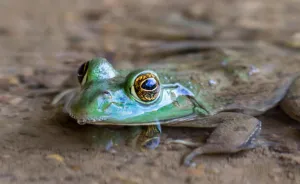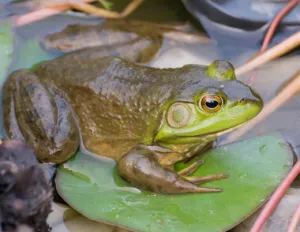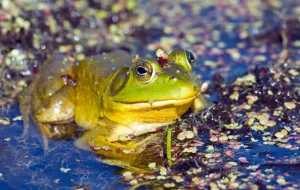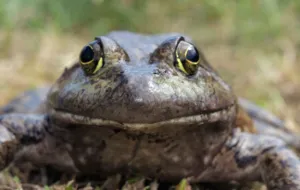
Table of Contents
Scientific Classification
- Kingdom: Animalia
- Phylum: Chordata
- Class: Amphibia
- Order: Anura
- Family: Ranidae
- Genus: Lithobates
- Species: Lithobates catesbeianus
Quick Overview
The American Bullfrog (Lithobates catesbeianus) is a prominent amphibian species native to North America. Recognizable by its distinctive deep croaking calls, the bullfrog is one of the largest frogs in the region and plays a significant role in aquatic ecosystems.
Fast Facts
- Scientific Name: Lithobates catesbeianus
- Lifespan: 7 to 9 years in the wild
- Average Length: 3.5 to 6 inches (males), up to 8 inches (females)
- Diet: Carnivorous, preying on insects, small fish, and even other frogs
- Habitat: Aquatic environments, including ponds, lakes, and slow-flowing streams
- Conservation Status: Least Concern
Did you know?
The American Bullfrog is often referred to as the “bullfrog” due to the male’s distinctive deep, resonant call, reminiscent of a bull’s bellow.
Appearance
American Bullfrogs have robust bodies with smooth, green or brown skin, featuring darker markings. Their hind legs are muscular, adapted for powerful jumps, and they have webbed feet. Males are typically smaller than females.
Size and Weight
Adult male bullfrogs range from 3.5 to 6 inches, while females can grow up to 8 inches. Weight varies, with larger individuals reaching over a pound.
Temperament and Behavior
Bullfrogs are known for their voracious appetite and are opportunistic feeders. They are skilled hunters, ambushing prey with their quick strikes. While predominantly aquatic, they can travel on land and are strong swimmers.
Fun Fact
American Bullfrogs have an extendable, sticky tongue that aids in catching prey. They can consume large insects, small mammals, and even other frogs.
Habitat and Distribution
These frogs inhabit a range of aquatic environments, including ponds, lakes, rivers, and marshes. They are widespread in North America, with a range extending from Canada through the United States to Mexico.

Care Guide
American Bullfrogs are not recommended as pets for inexperienced amphibian keepers due to their specific needs. In captivity, they require spacious aquatic enclosures with proper heating, lighting, and a diet that replicates their natural feeding habits.
Diet and Nutrition
As carnivores, bullfrogs consume a diverse diet, including insects, spiders, small fish, and amphibians. In captivity, a well-balanced diet with vitamin and mineral supplements is essential for their health.
Health and Wellness
Maintaining clean and well-filtered water is crucial for their health. Captive bullfrogs may face health issues if water quality is not adequately maintained.
Reproduction
Breeding occurs in late spring to early summer. Males attract females with their calls, and the females lay large masses of eggs in the water. Tadpoles undergo metamorphosis, transforming into juvenile frogs.
Conservation Status
The American Bullfrog is listed as Least Concern by the International Union for Conservation of Nature (IUCN). However, in some regions, their introduction has led to ecological imbalances, impacting native species.
Fun Fact
The powerful jumps of American Bullfrogs are attributed to their muscular hind legs, and they can cover significant distances both in and out of the water.
Photo Gallery




Related Profiles
- Leopard Frog
- Pickerel Frog
- Wood Frog
3 Fascinating Facts About American Bullfrogs
- Acoustic Communication: Male bullfrogs use their distinctive calls to establish territory and attract mates, creating a unique acoustic environment in wetlands.
- Metamorphic Transition: The transformation from tadpole to adult involves a fascinating metamorphic process, including the development of limbs and the absorption of the tail.
- Invasive Impact: The introduction of American Bullfrogs to non-native areas has led to declines in local amphibian populations and changes in ecosystem dynamics.
- Enchi Ball Python: A Unique and Stunning Morph of Python regius - March 27, 2025
- Emerald Tree Monitor: The Enigmatic Green Guardian of the Rainforest - March 26, 2025
- The Egyptian Cobra (Naja haje): A Fascinating Serpent - March 25, 2025
